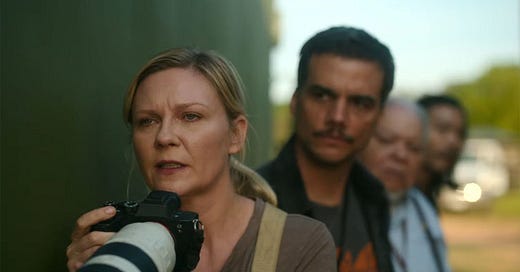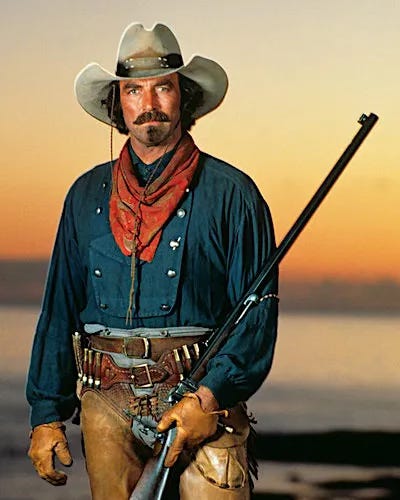Don’t worry. This is going to be a lot less hoity-toity than the title sounds.
Last week, my husband and I watched two movies side by side, and the contrast between the two couldn’t have been more stark. I had reached the end of a long day. and all I wanted to do was vegetate with my knitting. Jonathon suggested we also watch a film. He’d been eyeing a new one on Amazon with Kirsten Dunst in it called Civil War and I agreed without much thought.
Not surprisingly, Civil War wasn’t precisely what my tired body, mind and soul called for. In addition to the steady stream of violent, somewhat graphic snapshots, it was oddly…boring. The pacing was mighty slow. I think it was meant to be artistic or something. But it just came across as warmed over nihilism. Sort of. More on that later.
So, we stopped that film and dusted off an old favorite instead: Quigley, Down Under. And we thoroughly enjoyed it for the fourth, fifth, sixth (?) time! The movie ended and we went to bed feeling a bit lighter in heart than when we began.
I’ve been thinking about why for a couple days now. Quigley, Down Under didn’t shy away from the evils we all encounter throughout life, nor was it any less violent than the first film, though it was less graphic. Civil War contained depictions of evil, atrocities and human suffering. So did Quigley, Down Under. The first gave hints of meaninglessness, but the last fairly shouted endurance, hope, and courage.
I’ve come to the conclusion that the difference was in the worldviews underpinning each film. My difficulty here is pinning down the worldview of the first film. I have no problem with the last because it is very familiar to me. It is the worldview of hope
Civil War centers around a ragtag group of journalists racing the various battle fronts of civil war-torn America to Washington DC. The goal is to get an interview with the president before the rebels reach DC and take him out. It’s pretty obvious who the president figure is supposed to represent by the hints given in one of the opening scenes. Our fictitious president is serving his third term in office, has disbanded the FBI, and has reporters and journalists shot on sight out of principle whenever they show up. This is who Hollywood thinks Donald Trump is, by the way. And though you all know I neither love nor hate Donald Trump, I know better than that, and so should they. Anyway…
The journalists are simultaneously the victims and heroes of this film. Yes. They are the victims not the people they photograph being burned alive, blown up, hung by their wrists for days, and executed without trial, etc… They are also the heroes because they’re going to Washington in spite of the fact that President Trump will try to shoot them when they show up. The martyrdom complex is strong in this film.
Much emphasis is placed on taking the photo, the perfect photo. The main character says something along the lines of, “We’re not here to ask questions. We’re here to take the photo so that other people ask the questions.” The main ethos seems to be, “When all meaning is gone, find meaning in perfectly executed photos of blood and guts strewn all over the ground. Find artistic meaning in annihilation.”
As an aside, can we just take a moment to chuckle at the elevation of the journalist as the ultimate protector of truth in the minds of whoever came up with this plot? As if we all didn’t just live through years of radio silence from the “protectors of truth” on everything from the origins of Covid and Fauci’s beagle torture to 20,000 Haitians dropped into a small town overnight—a story that began two years ago and we’re JUST NOW hearing anything about it. Worse than radio silence, we’ve seen journalists, “the protectors of truth,” collude with our many corrupt institutions to cover up the truth time and time again. So, quit pulling our legs already.
I don’t even know what to call this world view. It’s some mixture of absolute despair and “take great, in-focus photos, whatever ‘great’ means to you.” It is incoherent, and so it is simultaneously depressing and boring in spite of the endless parade of gruesome spectacles
Quigley, Down Under couldn’t be more different, and it’s not just because the subject matter is different or that the genre is different.
Quigley is a tall, dark and handsome cowboy fresh off the boat from America, hired for his expertise in long range sharpshooting by a slimy British/Aussie rancher, Marston, played to perfection by Alan Rickman. (My goodness, that man could act, God rest him.) Quigley is not morally conflicted, bland and/or troubled, though he’s seen a fair piece of life—the good and the ugly. After arriving at Marston’s ranch along with Crazy Cora, a shell-shocked floozy dame who takes to calling him “Roy,” Quigley realizes Marston has hired him to murder aborigines with his tricked out rifle. Unimpressed, Quigley pitches Marston, headfirst, through his own window and an epic battle ensues that last the entire movie.
Quigley, as I mentioned before, is not a morally conflicted hero. He knows what the right thing is and he does it. He is immovable in his resolve. Marston, on the other hand, is morally bankrupt which leads to a kind of insanity characterized as bloodlust. He, too, is immovable in his resolve. Crazy Cora is morally compromised and she knows it, and this leads to its own kind of insanity.
The film offers a bit of backstory for both characters. Marston is a child when the aborigines attack his parents’ ranch and kill everyone they can get their hands on. Across the pond in America, Cora hides in the cellar with her baby from what she believes is a Comanche attack. When the Indians finally leave, she realizes she has smothered her child to death in an effort to keep him quiet. Unable to cope with what has happened, her husband sends her away, effectively divorcing her.
Marston’s loss turns malignant and he now hunts aborigines in an effort to wipe them out and/or drive them off his thousands of acres of land, whichever happens first. He never confronts his own evil. He revels in it. Cora, on the other hand, does confront her own evil, rejects it, and is returned to sanity.
In the end, Marston is defeated and Quigley and Cora begin a new life together. The story is full of courage and hope because the worldview of the writer was a worldview of hope.
You can’t have a worldview of hope without knowing deep down that there is truth, goodness, and beauty in the world, and that all of these things are worth fighting for. As a Christian, I go even further. I say there is truth, goodness, and beauty in the world because there is a Being of truth, goodness, and beauty who created the world. He is the God I worship.
You also can’t have a worldview of hope without confronting the reality of human evil and the human soul’s craving for redemption. Quigley portrayed this. Civil War did not. Civil War was a “we just take the pictures, we don’t ask the questions” approach to the problem of evil. Inadequate, in my opinion.
Alexander Solzhenitsyn encapsulated a universal truth about life and human existence in this way:
Gradually it was disclosed to me that the line separating good and evil passes not through states, nor between classes, nor between political parties either—but right through every human heart—and through all human hearts. This line shifts. Inside us, it oscillates with the years. And even within hearts overwhelmed by evil, one small bridgehead of good is retained. And even in the best of all hearts, there remains… an unuprooted small corner of evil.
Yes, indeed. Even within the hearts of journalists. This the problem of the sin nature which my Bible records.
The best stories, you see, are the stories that get closest to the universal truths about humans and life and everything else.
Whether the writer of Quigley was a Christian or not, the writer’s worldview was more true than the worldview of whoever wrote Civil War. And that’s why Quigley was worth watching and why Civil War really just…wasn’t.
I discovered another old hymn today which seems to fit nicely with my theme, here. It’s called What Adam’s Disobedience Cost and you can listen to it by clicking play up at the top of this piece and skipping to nearly the end. Enjoy!
That’s all for now. Until next time, folks…
P.S. If you enjoy reading my stuff, please consider upgrading your subscription from free to paid. This will help me fund my efforts to get my two novels published as well as free up more time to brainstorm topics and fully flesh them out. Thanks for your consideration! Have a great week!





Your description of the show Civil War sounds like a 21st century version of a progressive's dream, fueled by a handful of Quaaludes; boring on all counts! Since we don't access pay to view stuff I guess we won't see Quigley, it sounds tolerable. Thanks!